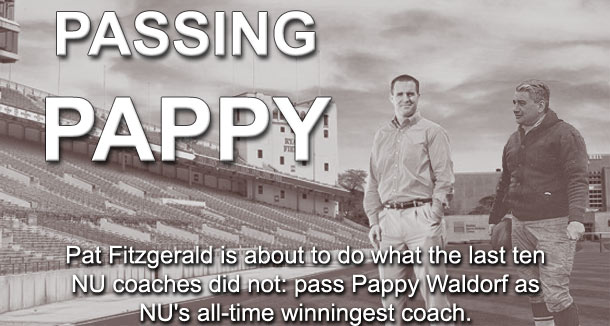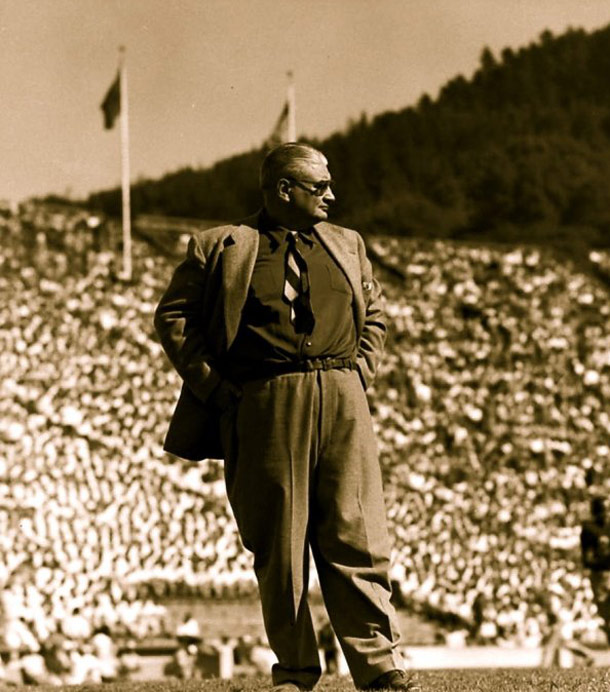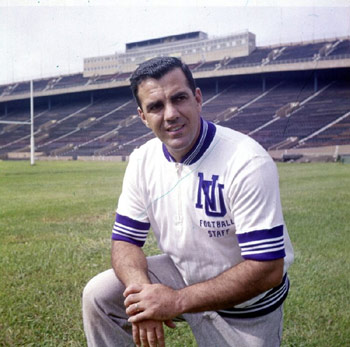|
|
 |
|
|

By GoUPurple
As
his seventh season as head coach of the Wildcats concludes, Pat
Fitzgerald stands at the threshold of winning more games at
Northwestern than any coach before him. When he wins his fiftieth
game, either with a long-sought January 1 bowl victory or a
non-conference win early next season, he will pass Lynn “Pappy” Waldorf
for the record. Doing so, Fitzgerald will break one final streak
of frustration, bad luck and heartbreak that remains from
Northwestern’s football challenges in recent decades: Fitzgerald will
have stayed at NU long enough to have passed Pappy, long enough to have
contributed to a stable and enduring football program with a
long-tenured coach. Great coaches have appeared in Evanston
between the terms of these two men—Voigts, Parseghian, Agase, Barnett,
and Walker among them—but none stayed, or could stay, long enough to
make it to 50 victories.
It is not a groundbreaking mark only for Fitzgerald. As we will
see, it is a landmark for the school and the program as well.
PAPPY
The man whom Fitzgerald will pass, Lynn Waldorf, had a successful
coaching career before he came to Northwestern and an even more famous
one after his departure from Evanston. Like Fitzgerald,
Waldorf was a two-time All American as a player (for Syracuse), and
like Fitz, Waldorf became a head coach at a very young age.
Waldorf made his head coaching debut in 1925, at age 23, at Oklahoma
City University. He coached there for four seasons, turning
around the fortunes of that small school’s team and earning a
conference championship.
Waldorf entered coaching at the major college level in 1929 at Oklahoma
State. He was a stunning success, powering the Cowboys to three
Missouri Valley Conference championships during his five seasons in
Stillwater. From there, Pappy made a one-season stop at
Kansas State, coaching the other Wildcats to a Big Eight Conference
title.
Noting Waldorf’s reputation as an up and coming coach, NU athletic
director Tug Wilson began to work to replace Northwestern’s coach, Dick
Hanley, with Waldorf. Hanley had coached the ‘Cats to
back-to-back Big Ten titles in 1930 and ’31, but his team was in a
brief slump, and Hanley had lost support of the NU
administration.
Even during this period in Northwestern’s football history, a period
festooned with conference titles and near misses at national titles, a
problem was beginning to crop up between the football head coach and
the school’s administration and athletic director. At a school
with such recruiting, admissions, and academic restrictions as
Northwestern, it can become very difficult to achieve and maintain a
balance between providing its football coach with the support he needs,
jeopardizing the school standards, or undercutting support for its
coach—through negligence, indifference, or even hostility. With
Hanley, it had become a hostile withdrawal of support. And so,
after eight seasons, NU’s winningest coach, the only coach to date with
multiple Big Ten titles, was essentially forced out, and Waldorf was in.

Pappy prowls the sideline in California [HTP Photo Archive]
Waldorf, as he had in each of his previous schools, struck immediate
gold. During his first season he led the ‘Cats to a seismic upset
of Notre Dame, in South Bend, just one week after the Irish had beaten
Ohio State in the original “game of the century.” The game is
famous for a twist that Waldorf, along with assistant coach Litz
Rusness, developed: the shifting defense. Before the ’35
game with the Irish, most defenses lined up in the same formation the
entire game. Instead, Waldorf’s ‘Cats paid attention to the
offensive formation, then shifted from a 5-3 formation into a formation
more suitable to defend the offense as set. The result was a 14-7
upending of the Irish. The win allowed Waldorf to claim the very
first national coach of the year award at the end of the ’35 season.
The following year NU would lose to Notre Dame, which might seem a bit
of a letdown, until one realizes that the 1936 NU – Notre Dame game was
to determine the national championship. Northwestern, in Pappy’s
second season, had beaten Minnesota, snapping the Gophers’ 28-game
unbeaten streak and earning itself the #1 national ranking in the AP
Poll’s first year. The ‘Cats would lose out on the national
championship (which Minnesota would ultimately claim, though it did not
win its own conference), but would win the unshared Big Ten title.
Waldorf was winning games, and he was doing so by bringing in top
flight talent, including Bob Voigts and Bernie Jefferson (both of whom
had key roles in the ’36 title season), Bill DeCorrevont (the national
#1 recruiting pick and to this day NU’s top-rated recruit), and of
course halfback Otto Graham.
Graham had come to NU on a basketball scholarship and was a music
major; his place on the Dyche Stadium grass was supposed to be as a
French horn player for NUMB. However, Graham was also a skilled
baseball player and a versatile football player, and during his
freshman year he guided his fraternity’s intramural football team to
the IM championship. Waldorf watched, and he made his move,
recruiting Graham for the Wildcat football team.
Pappy’s observation paid off. Graham’s 1941 football debut
was a stunner. He helped to dismantle Waldorf’s old school,
Kansas State, 51 to 3 in the season opener. Graham was set to
begin a three-year campaign to tear apart the Big Ten’s passing records
en route to All American honors and a place as one of NU’s greatest
athletes. By 1943 Graham was a commanding figure in the
conference, and Pappy had surpassed Hanley’s win record, taking the
title of the all-time winningest coach at NU.
The following three seasons, however, were somewhat disappointing, and
by the end of the 1946 season, Pappy had become frustrated with the
school and its restrictions. When asked at one point about the
relatively small number of players NU had on its roster compared to
other Big Ten teams, Waldorf had complained, “Overall, things were
uneven at Northwestern. We were never able to offer as much
financial aid as we were allowed to under the rules.”1
When the University of California’s athletic director offered Waldorf
that school’s head coaching position—and a sizable raise—Waldorf
countered by requesting control over his staff and that he would report
to the president of the university2, shaking off the restrictions that
had encumbered him at NU. And so, in early 1947, with 49 wins
after 12 seasons as the Wildcats’ coach, Pappy Waldorf left for Cal.
While head coach of the Bears, Waldorf enjoyed a string of three
straight Pacific Coast Conference titles and three straight Rose Bowl
appearances. The first Rose Bowl for Pappy was, of course, the
1949 Rose Bowl against his former team and his former student,
Northwestern, coached by Bob Voigts.
THE COACHES SINCE PAPPY
Voigts, another very young head coach, resembled Fitzgerald even more
than Pappy did. Voigts was an NU alumnus, who as a Wildcat player
was named All American. He, like Fitz, was 31 years old when he
took the reins at NU. He was a former assistant coach, but had no
experience as a coordinator or head coach.
When Voigts in his second year led the ‘Cats to the famed Rose Bowl win
over Pappy’s Cal Bears, it seemed that Voigts was the perfect fit for
Northwestern. But that fit was not to last. As with Hanley
and Waldorf, Voigts found his team in a rut a few years after stellar
success. And as it had with Hanley, the administration decided to
cut itself free of its coach. Voigts found alumni and
administration support evaporating toward the end of the 1954 season,
and he left, essentially forced out as Hanley had been.
Voigts’s successor, Lou Saban, did not work out, but the next coach,
Ara Parseghian, certainly did. Parseghian rebuilt the team,
recruited top-flight talent, and by 1958 had the Wildcats poised to
make a series of runs at the conference. While NU did not win a
title under Parseghian, it came close several times, and it remained
very competitive. By the end of his eighth season at NU, however,
Parseghian had also become as frustrated as his predecessors.
Northwestern would not
budge on its academic restrictions, which was OK, but it also did not
give its football coach the level of control and resources that other
Big Ten schools afforded their programs. “I’m restive,” Parseghian
famously uttered when asked about his possible plans to leave
Evanston. Eventually, he did, for a school that promised more
resources, and had the tradition to back it up: Notre Dame. The “Era
of Ara” ended after the 1963 season, and Ara had 36 wins and one game
over a .500 record. He would be the last coach to leave Evanston with
a winning record.
One of Parseghian’s
assistants, Alex Agase, took the helm in 1964, struggled for a few
seasons, and then hit gold in 1970, taking the ‘Cats to the brink of a
title and a Rose Bowl bid two years in a row. During his nine seasons,
Agase notched 32 wins. However, he also became unhappy with the
support he had received from the Northwestern administration.
|
|

Ara: the Coach Who Would Be King
[HTP Photo Archive]
|
Agase had even more reason to complain: in 1970 Robert Strotz became
the president of Northwestern, and Strotz was not one to increase money
and resources for athletics. Again, Northwestern had a solid
coach. Again, the coach grew disappointed with the resources
available to his program. And again, he was denied what he needed
to succeed. Agase left for Purdue before the 1973 season.
So began the Dark Ages. Coaches Pont, Venturi, Green, and Peay
had no realistic hope of claiming win #50 at Northwestern. Green,
realizing the futility of hoping for what he needed to succeed at NU,
bolted for Stanford. Pont, who was by 1977 also the athletic
director, removed himself from command after five seasons.
Venturi and Peay were let go. But NU’s next president, Arnold
Weber, was setting the stage for the end of the Dark Ages, and the next
coach would again have a shot at passing Pappy.
Gary Barnett’s first few years at NU and fantastic run through the Big
Ten in 1995 and 1996 put him half way to 50 wins. However,
Barnett often looked for another home, and by 1998 his search had
picked up. Part of this was Barnett’s own wanderlust; however, a
significant reason for Barnett’s resume blizzard was the same old
problem that had plagued the football program for nearly 70
years. Barnett, holder of two Big Ten football titles, NU’s first
since Pappy, was being paid less than incoming basketball coach Kevin
O’Neill. Athletic director Rick Taylor had shown Barnett a
surprising level of disrespect, and when Barnett made a fairly
reasonable plea for more resources, the response was much the same as
it had always been. And so, Barnett took the opportunity to
return to Colorado, after winning 35 games at NU, one shy of Dick
Hanley.
When Taylor announced Randy Walker as Barnett’s successor, the first
piece was in place at having a coach who would stay the distance and
build an enduring program at NU. The second piece was Taylor’s
own replacement four years later. Mark Murphy was a director who
understood the vital importance of keeping his good coaches, and he was
determined to keep Walker, who was at that point three years removed
from the 2000 Big Ten title and had placed the program back on stable
ground. In the spring of 2006, Murphy signed Walker to a contract
extension through 2011. The extension would have meant Walker
would have been at Northwestern for 13 seasons, one longer than
Waldorf. Walker was ecstatic, and the pattern of frustration,
disappointment, and erosion with Northwestern’s football coaching
position was at last at an end. It seemed Walker was destined to
pass Waldorf and surpass 50 wins.
Nothing, sadly, is what it seems. The pattern indeed, had ended,
but it would take the next coach to reach the milestone. The
Wildcat nation lost Walker, but Fitzgerald is just as committed.
Murphy moved on, but his successor has shown an even more passionate
commitment to the program and to its longevity. And so a new
milestone is to be set. And never in our lifetimes will we see
the coach who will eventually pass Fitz.

1-2: Cameron and Greenburg, Pappy, The Gentle Bear, 2000.
Other references: Paulison, The Tale of the Wildcats, 1951.
LaTourette, Northwestern Wildcat Football, 2005.

|
|
|
